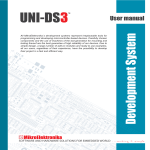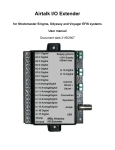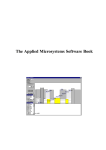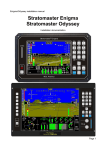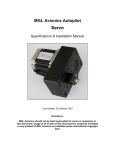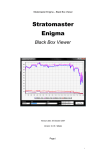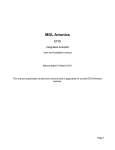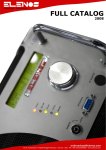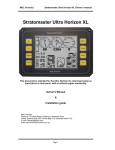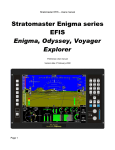Download SP-6 Installation Manual
Transcript
SP-6 magnetometer User manual Installation and in-flight calibration Note: This manual is applicable for SP-6 systems that contain in-flight calibration firmware released by MGL Avionics around the 15th of July 2013 Upgrading older SP-6 units to in-flight calibration firmware Download the Windows based update application from www.MGLAvionics.co.za/SP6.html. The application has been tested with Windows XP, Vista and Windows 7. This update will install new firmware into an existing SP-6 magnetometer based compass. You will need to construct a suitable RS232 cable. RS232 connection from SP-6 to PC -------------------------------Please construct a RS232 cable from a PC serial port to the SP-6 RS232 port. Pinouts for the SP-6 are on the sticker. Note: PC DB-9 male connector: TX is pin 3 RX is pin 2 Ground is pin 5 Wire TX to pin 3 on the SP-6 Wire RX to pin 4 on the SP-6 wire ground to pin 1 or 2 on the SP-6 Supply the SP-6 from a stable 12V DC power source. A reasonable quality 12V DC wall AC/DC adaptor suffices. A 12V lead-acid battery is also a good choice. Updating the SP-6 Run the application ARMPROG.EXE on your Windows PC. Select the serial port to use in the setup. You can choose COM1 to COM16. If none of these are available, please reallocate an unused port in your windows setup (control panel) to fall in this range. Often, if you use USB to serial adapters, a new port number is allocated every time Windows thinks it is for a different USB port or application. Control panel -> System -> Hardware -> Device manager -> Ports(COM&LPT). Then select the port currently allocated by your USB converter (for example COM32) then -> Port settings -> Advanced -> choose a port number in the range COM1 to COM16. With ARMPROG running and the SP-6 connected, switch on power to the SP-6. If all goes well ARMPROG now shows "ready to program". Click the "Program" button and wait for the message "Application programmed". This takes less than a minute. Close ARMPROG and verify that the SP-6 starts with the new code. Remove power from the SP-6 and re-apply. After a few seconds the LED should start flashing. Testing the SP-6 using the PC Download the Windows based interface application from www.MGLAvionics.co.za/SP6.html. Run the program SP-6.exe and choose the serial port used in the setup. Connect and power up the SP-6. You should see heading and magnetic vector information displayed. The heading should change when you rotate the compass but will likely be wrong. That is expected. The heading will only be correct once you perform the calibration procedure. This is done with the compass installed in the aircraft using a connected EFIS or other compatible display instrument. The Windows SP-6 application can do this as well but it is not normally used for that. The SP-6 application allows you to test the procedure in your home by "flying" the compass in a similar manner to what you would do in the real aircraft. To do this ensure you are well removed from any metal structures (including chairs and furniture that may contain metal and remove your watch and any keys from your pockets). Place the SP-6 level and then click "start in-flight calibration". The heading display changes to 111 to indicate start of calibration. Now proceed to SLOWLY bank the compass and fly it at different bank angles, different pitch angles in circles and figure-of-eights or "clover leaf" patterns. Note the samples counter. It should count up and when reaching 36 the heading changes to 222. This is an indication to the pilot that he is doing OK and the compass is taking measurement samples. Continue until the samples counter reaches 100. At this point the compass starts to show measured headings. Continue the calibration "flight". Note the "fit" display. It will likely now be over 95%. The aim is to get a high as possible number which indicates a high confidence in the quality of the magnetic samples taken so far. Values over 98.5% are good. At this point the pilot can start flying straight and level sections to compare the heading with a reference to check for accuracy. The calibration flight can continue until the results are satisfactory. The sample count will stop at 150 however further samples are taken (new samples replace the oldest ones). When satisfied with the result the calibration is ended by clicking on "end in-flight calibration". This causes the SP-6 to save its current correction state for future reference. You can test the internal accelerometer of the SP-6 and calibrate it. Use the "raw data snapshot" to obtain roll and pitch information. This should agree with the attitude of the SP-6. The text on the application explains how to recalibrate if required. It is a simple 4 step process. The internal accelerometer is used ONLY for display devices that do not have an AHRS as attitude source. In this case the accelerometer is used to tilt-correct the heading if the SP-6 is not level. Note that this does not work when an aircraft is in a banked, balanced turn as the accelerometer cannot give you attitude in this case. SP-6 installation The in-flight calibration is able to compensate for hard and soft iron distortions of the Earth's magnetic field at the SP-6 location caused by metals on board your aircraft. In order to do this the calibration flight must expose the SP-6 to as many different attitudes and orientations as possible to the direction of the Earth's magnetic field. This way the SP-6 can measure the distortions and then compensate for them. This can result in a very accurate magnetic heading measurement. Unfortunately the magnetic properties of metals on your aircraft will change over time and this will re-introduce heading errors form the SP-6 necessitating a new calibration. To minimize this problem, please locate an area in your aircraft that is as free from magnetic deviations as possible. You can use a hand-held hiking compass to aid you in locating metals in your aircraft that affect the Earth's magnetic field. Never install the SP-6 with mild steel screws or similar or on brackets/shelves that contain magnetically active metals. Use a small magnet to find "bad" metals. If the magnet sticks you have a problem. Use plastic, aluminum, copper or brass if in doubt. You can also consider heavy duty self adhesive velcro for a simple and practical solution. The aim is to install the SP-6 in the best possible location with the most suitable fasteners. Be aware of airframe steel structural parts (steel tubing), engines, engine mounting brackets, steel control cables and rods, nuts and bolts etc. Be especially wary of electrical wiring. Electrical currents cause magnetic fields around the cables. These fields can be very strong when compared with the weak field of the Earth. Ensure that there are no electrical wires close to the SP-6. This includes the wires going to the SP-6 itself. Route these away from the SP-6. The actual magnetic sensor is installed close to the "SP-6" wording on the label. Be aware of engine starter motors, electrical solenoids, relays, electric motors, servo motors including autopilot servos. All of these create very strong magnetic fields and must be located at least three to six feet away from the SP-6, preferably more. Do not install the SP-6 close to baggage areas or pilot/passengers - a bunch of keys in a pocket or luggage is all it takes to induce a heading error. The SP-6 relies on the fact that all magnetic disturbance sources will remain unchanged and in the same location and they they move and rotate with the SP-6. Any disturbing source that moves relative to the SP-6 is considered time-variant and cannot be corrected for. In-Flight calibration Fly the aircraft in safe area where you can perform random banked turns. Do not exceed the safety limits of the aircraft during the calibration flight. Start the calibration in the Compass setup menu of your display device. You should see the compass heading change to “111” to confirm that calibration has started. If your display device has any type of heading alignment function that can add or subtract from the heading please disable this. Fly a number of banked 180 or 360 degree turns at different bank angles - i.e. shallow, medium and steep turns. Try to add many different pitch attitudes in various orientations relative to the field direction. It does not matter in what order you fly the maneuvers. A typical, good calibration tends to take 5-10 minutes of flight. Do not activate any electrical equipment that creates large magnetic fields during the calibration process (for example starter motors, autopilot servos, landing lights etc). The heading starts reading 111 after you start calibration. After 36 initial samples have been collected this changes to 222. This should take approximately one turn. Continue the flight while maneuvering until the heading starts reading normally. This happens once the SP-6 has collected 100 distinctly different magnetic samples. At this point the heading should start showing reasonable numbers. Continue the calibration flight, settling into straight and level at intervals on different headings and verify the heading readout against an ACCURATE reference. Continue the flight until you find heading errors that are within 1 to 2 degrees, about the limit one can reasonably expect. When satisfied, end the calibration using the provided function in the EFIS or display device. This will save the calibration to permanent memory in the SP-6. Should you not be able to achieve a good heading readout, please locate the compass to a better location in the aircraft. Depending on the capabilities of your display device you may be able to view calibration sample count and fit percentage. The sample count will count up to 150 after which new samples replace the oldest samples stored. The fit percentage is a value from 0% to 100%. The aim is to get to a value as close as possible to 100%. The fit starts displaying other than 0% after the first 36 samples. Fit values of 98% and higher are considered good. If you cannot achieve this you do not have a good installation location for your compass. You may still get reasonably good heading accuracy despite a lower fit. However, to ensure long term accuracy please consider locating the SP-6 in a better area in your aircraft. If your display device can show you the fit error readout and you find the readout decreases suddenly by a large amount (for example from 85% to 42%), this is typcally caused by a strong time-variant magnetic field such as can be created by electrical equipment (motors, relays, current flow in cables). In such a case please either end and restart the calibration or continue the calibration flight until the fit error is acceptable again (the incorrect magnetic sample(s) will eventually be removed). It is advised to locate the interference source and either move this or the SP-6 to a better location in the aircraft. Note: should you move the SP-6 to a new location or fit new equipment close to the SP-6 you will have to perform the calibration again. There is no practical limit as to how many times you can perform and save a new calibration. Calibration functionality in the display device You will be using calibration functions called "in-flight calibration start" and "in-flight calibration end" with devices that are aware of this version of the SP-6. Such devices will also provide a function to show sample count and fit error. With older devices you will use "deviation start" and "deviation clear". You may get an error message after "deviation start" with the device complaining about loss of communications. Ignore this - if you see "111" as heading the calibration has started. "Deviaton clear" is the old "factory default" setting - if asked, say "yes" - this will end the in-flight calibration. Note: Should your display device have "line-up" functionality where you can correct small errors in heading, please clear all of these line-ups before calibrating as you will likely not see the "111" and "222" headings during calibration. Also with these corrections in place you will not be able to judge the quality of the current calibration. Judging the quality of the heading indication Using a good quality hiking compass with aiming lines, stand well behind the aircraft and line up compass and aircraft. Compare SP-6 heading and hiking compass heading. They should agree closely. In flight, the best option is using a GPS that can display ground track corrected for local variation. Note that many GPS receivers can only give you true track. In this case you have to convert true to magnetic yourself depending on your local variation. During flight, GPS magnetic ground track and compass heading should agree if you are flying straight into wind or with the wind so there is no side-wind component. Of course the two should also agree if you are flying in zero wind conditions. If you have a side-wind component, ground track and heading should show a deviation - this is the basis of wind speed and direction calculations. You should also see a deviation if you are flying straight but are slipping (i.e. ball not centered). Using AHRS correct tilt The SP-6 magnetometer based heading measurement is relative to the attitude of the SP-6 itself. In order to obtain heading relative to the Earth's surface (as is used in navigation), the heading needs to be corrected. In order to do this, we must know the attitude of the SP-6 relative to the Earth's surface. The SP-6 contains an accelerometer which is used for this. This however does not work in an aircraft if the aircraft is changing direction (in a balanced turn the accelerometer would think that the Earth's direction is at right angles to the floor of the SP-6 – it is of course not). This means if this method is used to correct for tilt, the heading will show an error during a turn (but is correct the moment you flight straight again). In order to have a correct heading even during a turn, an artificial horizon (AHRS) such as the SP-7 is needed. It is left to the display device to perform the tilt compensation using the AHRS to provide maximum flexibility. The SP-6 transmits the corrected magnetic vector to the display device so it is in a position to do so. How it works The SP-6 is designed to compensate for hard and soft iron distortions of the Earth magnetic field at the mounting location of the SP-6 itself. The SP-6 uses an algorithm partly based on common solutions such as published by Honeywell, Freescale, ST Microsystems and many other sources. MGL extends these solutions with a method that does not require any knowledge of the Earth magnetic fields characteristics or requires any form of external aiding during or after the calibration process. The calibration can be performed completely without any knowledge of the attitude of the SP-6 relative to the Earth magnetic field or the Earth itself. The calibration is performed using only the three raw magnetic readings from the internal magnetometer device. During the calibration process the SP-6 collects magnetic samples in the X,Y and Z axis of the compass sensor. These samples can be highly distorted by hard and soft iron effects as well as sensor offset issues. The SP-6 itself may also contain materials that can contribute to heading errors. The SP-6 looks for readings that differ in a measurable way and stores these in “bins”. For this to be possible, the SP-6 contains a second calibration algorithm that runs concurrently. This algorithm performs hard iron and offset calibration using common methods. This calibration however has no bearing on the main calibration software and is used only to quantify raw measurements. After a certain amount of samples have been collected the SP-6 will attempt to fit three circles to the data (X/Y, X/Z and Y/Z). Due to soft iron distortion the circles will end up looking like ellipses. The SP-6 uses a least squares fit to obtain the most likely shape of the ellipse in each axis even if only very few samples are available. Once the shapes of the three ellipses are known, these can be converted to circles – the correction needed for this is the “soft iron correction”. There will be three such corrections, one for each axis. The three ellipses describe a three dimensional single ellipse. The more samples are collected, the higher the probability of a good ellipse fit. After application of the soft iron correction, we now have a three-dimensional sphere and a three dimensional correction to transform the ellipse to a sphere. Once the sphere is known, it is centered around “0”. The transformation to do this corrects for hard iron and sensor offset. This transformation is a single three dimensional vector. On a more basic level, the SP-6 takes the Earth magnetic field as being constant and unchanging at the location where the calibration flight takes place. Using the three axis magnetometer, we can measure the strength of the field regardless of orientation. This is fundamental to the calibration. Any deviation caused by external soft iron distortion will cause the field lines to concentrate or fan out. This causes the strength of the field to change. It is this variation in strength that causes the measurement of an ellipse as the effects are naturally symmetrical (the effect is the same but with inverted sign if the offending part is in front of the SP-6 or behind – relative to the field direction). The fit error value transmitted by the SP-6 during the calibration is based on how far sample points deviate from the ideal ellipse shape. Due to measurement noise, 100% cannot be achieved but a value very close to this is possible. A high fit percentage results in a high probability that the calculated heading (after correction) will be very accurate. The firmware in the SP-6 is written entirely in a Pascal dialect and compiled using Embedded Pascal. Electrical connections for SP-6 Pin Number Pin Description 1,2 3 4 5 6,7 8 9 Ground (GND) / Battery minus RS-232 Receive (RX) RS-232 Transmit (TX) Airtalk Vin / Battery positive / +12V CAN Low CAN High The SP-6 is intended to be supplied by a 12V DC power source. Voltage range from 8V to 16V is normally used. Please consider a pre-regulator or an MGL Avioguard if you would like to operate the SP-6 from a 24V DC power source. Newer MGL Avionics devices use the CAN bus for data transmission. This is a dual wire, twisted pair communications bus that can be shared with many devices on the same bus. In order for the bus to operate, it needs to be terminated with two 60 ohm resistors (68 ohms is often used as it is an easy to obtain standard value) Relatively short CAN buses (6 feet or less can use a single 120 ohm resistor placed anywhere between the two CAN wires) . One resistor is fitted to each end of the CAN bus and any device not at the end points of the CAN bus connects to the CAN bus using a SHORT wire stub. Older devices use the airtalk bus. This is a single wire connection that can support a few devices on the same link (typically SP-6 plus an AHRS). Normally a single core shielded wire is used with the shield connected to ground. This bus does not require termination resistors. The RS-232 link is not used with MGL devices. It is intended mainly for third party applications but is also used to load the firmware.









